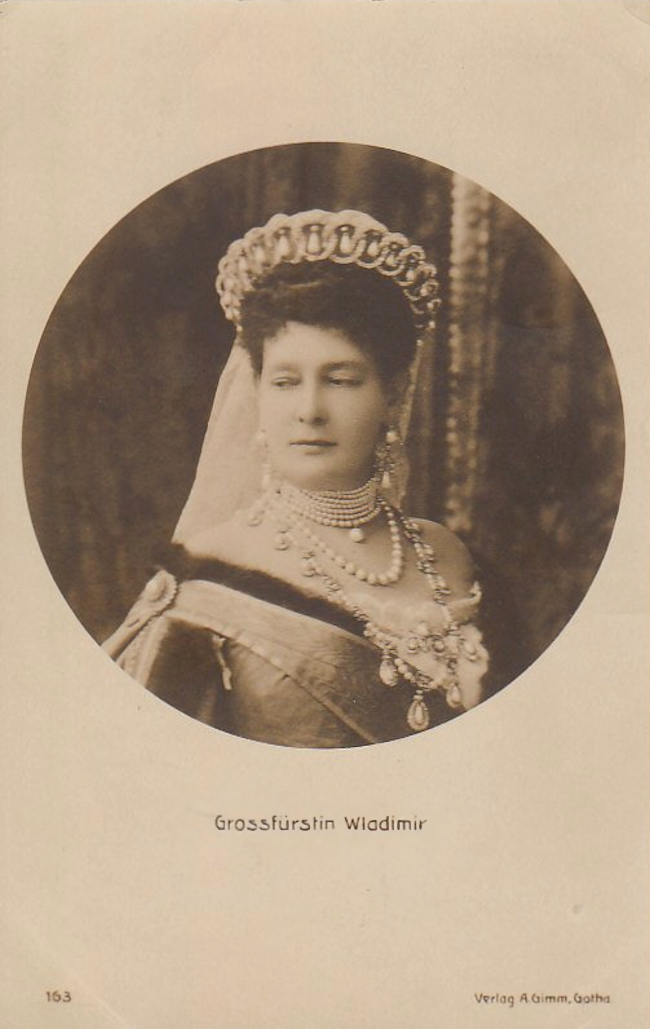 |
| 1911. This appears to be a preparatory sketch for the finished painting which was only completed two years later. |
 |
| 1913. In the final version, the Grand Duchess is portrayed wearing an entirely different court gown and jewels. |
***
 |
| The famous "Vladimir tiara", now in the collection of the British royal family, worn in the two images above and in the first painting. |
 |
| An earlier image of the Grand Duchess wearing the sapphire and diamond necklace worn in the second painting and showing the original setting of her sapphire and diamond tiara. |
 |
| The new version of the sapphire and diamond tiara (1909) and the devant de corsage (1910) worn in the second portrait; both by Cartier. |
***
Edited - heavily - and adapted - a lot - from the Sotheby's website:
This second portrait of the Grand Duchess Vladimir (1854-1920, sometimes referred to as "Grand Duchess Maria Pavlovna the Elder"), is dated 1913. Kustodiev completed the painting almost two years after making his initial study. The subject was the daughter of the Grand Duke of Mecklenburg-Schwerin Friederich Franz II and Augusta of Reuss Kostritz. Princess Marie of Mecklenburg-Schwerin would become a key figure in the life of the Russian capital after her union with Grand Duke Vladimir Alexandrovich of Russia (1847-1909), son of Emperor Alexander II. Among other things, Grand Duke Vladimir was President of the Imperial Academy of Arts in St. Petersburg and the Grand Duke’s financial support - from his private funds - allowed many artists to flourish beyond the conservative boundaries and culture of the Imperial court. The Grand Duchess Vladimir took over the Presidency of the institution after the death of her husband in 1909; in Kustodiev's portrait she stands before a bust of her husband, and the Imperial Academy of Arts can be seen in the background, its presence symbolic of their lifelong involvement with the arts.
Kustodiev painted the dominating figure of Grand Duchess Vladimir, proud and dignified and covered in spectacular jewels – she was famous for her jewelry. In fact, it is said that she spent much of the annual pension of 1 million gold francs she received after the death of her husband on her jewelry. In Kustodiev’s portrait, she wears her famous sapphire and diamond diadem commissioned from Cartier 1909; the firm re-used stones belonging to the client, the central sapphire weighing 137.20 carats The tiara later belonged to her niece, Queen Marie of Roumania, whose daughter, Princess Ileana, sold it back to Cartier in the Fifties. The stomacher (devant de corsage) worn by the Grand Duchess was also made by Cartier, again using the client's stones, in 1910. The necklace and earrings appear to be Russian and of an earlier date.
The Grand Duchess fled St. Petersburg in February 1917. She settled in Kislovodsk in the Caucasus until February 1920, when she finally left Russia. Remarkably, her jewels which she placed in a secret safe in the Vladimir Palace, had remained undiscovered by the Bolsheviks despite repeated searches. Albert Stopford, a British secret agent and family friend, recovered the jewels and the Grand Duchess’ jewelry eventually found its way to Cartier, Paris in a diplomatic pouch; Cartier has archival photographs of all of the Grand Duchess Vladimir’s jewels taken around 1920. After the Grand Duchess’ death on September 6, 1920, the jewels were divided among her children: Grand Duke Kyrill received the pearls, Grand Duke Boris the emeralds, Grand Duke Andrei the rubies, and Grand Duchess Elena the diamonds.


Love the photograph. Quite evocative, especially her regal bearing.
ReplyDeleteI can only imagine how heavy those jewels were and uncomfortable. but undeniably beautiful.
ReplyDeleteIsn't the Vladimir Tiara the one that Princess Di wore??
ReplyDeleteNo, this was never worn by The Princess of Wales. Queen Mary bought the piece in 1921 and wore it until her death in 1953, when it passed to the present Queen. The tiara you're thinking of, the one that the Princess of Wales so often wore, is known as the "Queen Mary's Lover's Knot Tiara". (It is sometimes mistakenly called the "Cambridge Lover's Knot Tiara", which it actually was a copy of; the original had belonged to the Queen's aunt and godmother, the Grand Duchess of Mecklenburg-Strelitz.) Certainly there are similarities between the two tiaras, mainly the arched design and the pendant pearls.
DeleteI love this blog. I am so happy when I see it in my in box.
ReplyDeletePlease write more details about the the subjects and the artists as it is fascinating.
I end up on Mr. Google for hours after one for your blogs.
You are so kind, andee. Thank you!
Delete